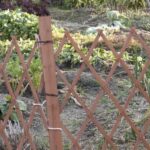Can you use treated pine for vegetable gardens? Many gardeners are drawn to the affordability and durability of treated pine when it comes to building raised beds for their vegetable gardens.
However, concerns about the chemicals used in treating the wood have sparked a debate about its safety and suitability for growing edible plants. In this article, we will explore the controversy surrounding the use of treated pine in vegetable gardens, understand how it’s treated, consider alternative options, and discuss best practices for using it safely.
As more people turn to gardening as a sustainable and healthy way of living, there is a growing interest in finding cost-effective materials for building vegetable garden beds. Treated pine, known for its resistance to decay and insects, has become a popular choice due to its affordability and availability. However, questions about its safety when used in contact with edible plants have led many to seek alternative solutions.
In this section, we will delve into the reasons behind the interest in using treated pine for vegetable gardens. We will also address the concerns and risks associated with its use, as well as explore any potential benefits of using treated pine despite the controversy. By understanding these factors, readers can make informed decisions about whether or not to use treated pine in their own vegetable gardens.
Understanding Treated Pine
Treated pine is a type of wood that has undergone a preservation process to protect it from decay, insects, and other environmental factors. The treatment involves applying chemicals to the wood, such as copper compounds and fungicides, to extend its lifespan and make it suitable for outdoor use. This process makes treated pine an attractive option for building garden beds and outdoor structures due to its durability and resistance to rot.
There are different methods for treating pine, with the most common being pressure treatment. In this method, the chemical preservatives are forced into the wood using pressure, allowing for deep penetration and better protection against decay. Another method is known as dip-treating, where the wood is immersed in a tank of preservative solution. These treatments can vary in their effectiveness and potential risks when used in vegetable gardens.
When considering using treated pine for vegetable gardens, it’s important to understand the treatment process and the potential risks involved. While treated pine offers many benefits in terms of durability and longevity, there are concerns about the chemicals used in the treatment process leaching into the soil and potentially impacting the health of plants and individuals consuming the produce.
An important consideration when using treated pine in vegetable gardens is selecting a treatment method that minimizes potential risks. Additionally, choosing a reputable supplier who follows best practices for treating pine can help ensure that the wood is safely preserved. Understanding how treated pine is made and knowing what chemical substances are used can assist gardeners in making informed decisions about whether or not to use treated pine in their vegetable garden projects.
| Treated Pine Characteristics | Details |
|---|---|
| Treatment Methods | Pressure Treatment, Dip-Treating |
| Chemical Preservatives Used | Copper Compounds, Fungicides |
| Potential Risks | Leaching into Soil, Impact on Plant Health |
The Controversy
Treated pine has long been a popular choice for building vegetable garden beds, thanks to its durability and affordability. However, the use of treated pine in vegetable gardens has sparked controversy due to concerns about the potential risks it poses to both human health and the environment.
Chemical Treatment Process
Treated pine is subjected to a chemical treatment process to protect it from decay, insect infestation, and rot. The most common method of treating pine involves the use of chromated copper arsenate (CCA), which contains arsenic, a known carcinogen. This substance prevents the wood from deteriorating, extending its lifespan.
Risks and Concerns
The controversy surrounding the use of treated pine in vegetable gardens stems from the potential leaching of chemicals into the soil. As water comes into contact with the treated wood, it
Environmental Impact
In addition to health concerns, there
As we delve into these concerns and risks associated with using treated pine in vegetable gardens, it becomes evident that alternative solutions may be necessary to ensure safety for both humans and nature alike in our pursuit of sustainable gardening practices.
Alternative Solutions
Treated pine has been a popular choice for building vegetable garden beds due to its affordability and availability. However, there are growing concerns about the potential risks of using treated pine in vegetable gardens, particularly when it comes to the leaching of harmful chemicals into the soil and potentially contaminating the vegetables grown in them.
If you’re looking for safer options for building your vegetable garden beds, there are several alternatives to consider. These options not only eliminate the potential risks associated with treated pine but also offer their own unique benefits for your garden.
- Unfinished cedar or redwood: These types of wood are naturally resistant to decay and can withstand moisture without the need for chemical treatment. While they may be more expensive upfront, they can last longer and are a safe and environmentally friendly choice for your vegetable garden beds.
- Composite lumber: Made from a mixture of wood fibers and recycled plastic, composite lumber is a durable and low-maintenance option for building vegetable garden beds. It is resistant to rotting, splintering, and insect damage, making it a long-lasting alternative to treated pine. Additionally, it does not require any chemical treatment, making it a safe option for growing vegetables.
- Stone or brick: For a more permanent solution, consider using stone or brick to construct raised beds for your vegetable garden. Not only do they provide excellent drainage and thermal mass for your plants, but they also eliminate any concerns about chemical leaching from treated wood materials.
Ultimately, choosing an alternative material for building your vegetable garden beds can provide peace of mind when it comes to the safety of your crops. By considering these safer options, you can create a healthy and sustainable environment for growing delicious and nutritious vegetables without the potential risks associated with treated pine.
Benefits of Using Treated Pine
Treated pine has been a popular choice for building vegetable garden beds due to its affordability, accessibility, and durability. Despite the controversy surrounding its use in gardening, there are some potential benefits of using treated pine in vegetable gardens.
One of the primary advantages of using treated pine is its resistance to decay and insect infestation. Treated pine is chemically infused with preservatives that protect it from rot, mold, and pest damage, which can prolong the lifespan of your garden beds. This means that you won’t have to replace or repair your garden beds as frequently as you would with untreated wood.
Additionally, treated pine is readily available at most home improvement stores and lumberyards, making it a convenient option for gardeners who are looking to build or replace their vegetable garden beds. The cost-effectiveness of treated pine is also an appealing factor for many gardeners, especially those on a budget.
While these benefits may make treated pine seem like an ideal choice for vegetable gardens, it’s important to consider the potential risks and environmental impact associated with its use. Gardeners should carefully weigh the pros and cons before deciding whether to use treated pine in their vegetable gardens.
| Advantages of Using Treated Pine | Considerations |
|---|---|
| Resistance to decay and insect infestation | Potential risks of chemical leaching into soil |
| Affordability and accessibility | Environmental impact of treated pine production |
| Durability and longevity | Possible health concerns from exposure to treated wood |
Best Practices
Consider the Type of Treatment
When considering using treated pine for your vegetable garden, it’s important to understand the different types of treatment that can be used. Some treatments, such as Chromated Copper Arsenate (CCA), have been phased out due to concerns about leaching chemicals into the soil and potentially harming plants and humans.
However, there are alternative treatments like Alkaline Copper Quaternary (ACQ) or Copper Azole that are considered safer for use in vegetable gardens. Before purchasing treated pine, make sure to inquire about the specific type of treatment used to ensure its safety for your garden.
Line the Interior With Plastic
To further reduce any potential risk of chemical leaching into the soil from treated pine, consider lining the interior walls of your raised garden bed with plastic sheeting. This extra barrier can provide additional protection for your vegetables and give you peace of mind when using treated pine in your garden.
Regular Maintenance and Monitoring
Even if you opt for a safer treatment option, it’s still important to regularly monitor your treated pine garden bed for any signs of deterioration or damage. Check for any loose or flaking wood that could expose the treated surface and potentially cause chemicals to come into contact with your soil.
Additionally, consider sanding down any rough areas and applying an additional sealant to further protect the wood and maintain the integrity of your garden bed over time. Regular maintenance is key to ensuring the safety and longevity of using treated pine in vegetable gardens.
Case Studies
I recently spoke with several gardeners who have used treated pine in their vegetable gardens, and their experiences varied widely. One gardener, Sarah, had initially chosen treated pine because of its affordability and availability. She built raised beds using treated pine and found that it held up well over several years and provided a sturdy structure for her vegetable plants. However, she did express some concerns about the potential leaching of chemicals from the treated wood into the soil.
On the other hand, another gardener, James, had a more negative experience with using treated pine in his vegetable garden. He noticed that after a few years, the wood began to show signs of decay and deterioration despite being labeled as “treated.” Additionally, he expressed concerns about the safety of growing vegetables in close proximity to treated wood that may contain harmful chemicals.
Despite these mixed experiences, one common theme among the gardeners I spoke with was the importance of thoroughly researching and understanding how their chosen materials could potentially impact their vegetable gardens. Many emphasized the need for careful consideration of alternatives to treated pine and weighing the potential risks against any perceived benefits.
Ultimately, these case studies highlight the importance of considering individual experiences alongside expert recommendations when deciding whether or not to use treated pine for vegetable gardens. It’s clear that while some gardeners have had success with this material, others have encountered issues that raise valid concerns about its suitability for growing edible crops.
Conclusion
In conclusion, the decision to use treated pine for vegetable gardens ultimately depends on weighing the potential risks against the benefits and taking the necessary precautions. While treated pine can offer a durable and cost-effective solution for building garden beds, it is important to recognize the potential health and environmental risks associated with its use.
By understanding how treated pine is made and treated, as well as considering alternative options such as cedar or untreated pine, gardeners can make informed decisions about what materials to use in their vegetable gardens.
It is crucial for gardeners to prioritize the safety of their produce and the long-term health of their soil by carefully considering whether or not to use treated pine. When considering using treated pine for vegetable gardens, it’s essential to take into account the possibility of chemical leaching into the soil and its impact on edible plants.
Gardening practices vary among individuals and communities, so it is also valuable to seek out advice from local experts or organizations that are knowledgeable about safe gardening practices.
While concerns exist about the potential risks of using treated pine in vegetable gardens, there are some benefits as well. Treated pine offers durability, resistance to decay, and affordability which may make it an attractive option for many gardeners.
However, it is crucial for individuals to understand these potential hazards before making a decision that could impact their health or environment long-term. Ultimately, each gardener must balance these factors when deciding whether or not to use treated pine in their vegetable garden.
Frequently Asked Questions
Can You Use Treated Pine for Raised Vegetable Gardens?
Using treated pine for raised vegetable gardens is not recommended. The chemicals used in the treatment process can leach into the soil and potentially be absorbed by the plants, posing a risk to human health.
Can I Use Treated Wood for Vegetable Garden?
It is generally advised against using treated wood for vegetable gardens due to the potential leaching of harmful chemicals into the soil. Safer alternatives include untreated wood or naturally rot-resistant options like cedar or redwood.
Can You Use Untreated Pine for Raised Beds?
Untreated pine can be a suitable option for building raised beds for vegetables. Pine is known for its durability and affordability, but it may not last as long as cedar or redwood without proper maintenance. Applying a natural wood preservative can help extend its lifespan.

If you’re looking to get into vegetable gardening, or are just looking for some tips on how to make your current garden better, then you’ve come to the right place! My name is Ethel and I have been gardening for years. In this blog, I’m going to share with you some of my best tips on how to create a successful vegetable garden.





